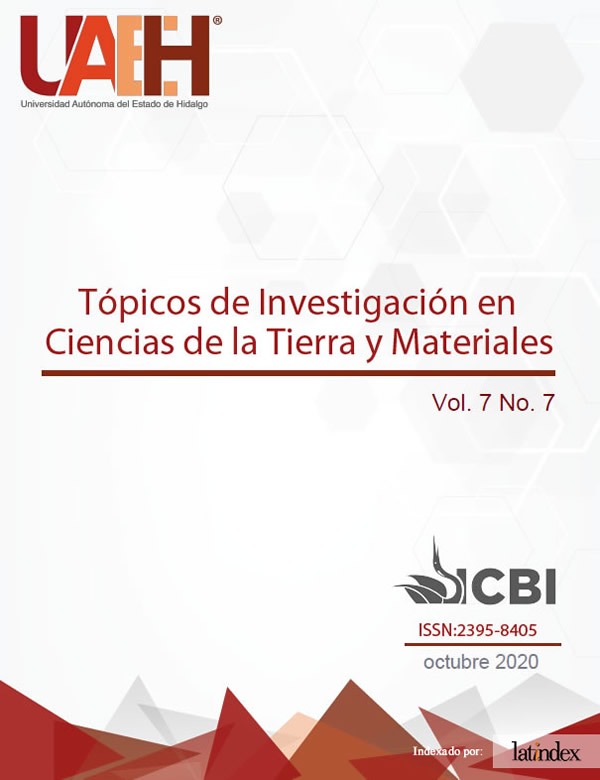Obtención de fase ferroeléctrica en cerámicos base BaTiO3 doblemente dopados con tierras raras
DOI:
https://doi.org/10.29057/aactm.v7i7.6064Palabras clave:
titanato de bario, Gd, Eu, fase ferroeléctrica, microestructuraResumen
Los materiales cerámicos con una estructura tipo perovskita como el titanato de bario ya sea sin dopar o dopado han sido de gran interés gracias a sus variadas aplicaciones eléctricas, entre ellas; capacitores dieléctricos, resistores, sensores térmicos, capacitores multicapa, etc. Las características de este tipo de materiales son determinadas por su microestructura y su composición química, estas variables son determinadas por el proceso de síntesis, la calidad de materiales precursores y la adición de dopantes. El presente trabajo tiene por objetivo sinterizar soluciones solidas tipo Ba1-3XGd2XTi1-3XEu4XO3, utilizando precursores de alta pureza en las concentraciones de x igual a 0.1%, 0.15%, 0.3% y 0.6% en peso, con el fin de obtener una fase ferroeléctrica dopada con 〖Gd〗^(3+) y 〖Eu〗^(3+). Las mezclas de polvos se sinterizaron a 1300°C por 6 horas. La evolución microestructural fue caracterizada por difracción de rayos X y microscopia electrónica de barrido. Los resultados mostraron evidencias de la evolución estructural, en las cuatro composiciones, de una fase ferroeléctrica (tetragonal).
Descargas
Información de Publicación
Perfiles de revisores N/D
Declaraciones del autor
Indexado en
- Sociedad académica
- N/D
Citas
Pavlovic VP, Nikolic MV, Nikolic Z, Brankovic G, Zivkovic Lj, Pavlovic VB y Ristic MM. Microstructural evolution and electric properties of mechanically activated BaTiO_3 ceramics. Journal of the European Ceramic Society 2007; 27: 575 – 579.
Rahaman, Ceramic processing and sintering, New York: Marcel Dekker, 2003.
George A, Rossetti Jr y Eric C. Stress induced shift of the Curie point in epitaxial lead titanaete films. Applied Physics Letters 1991; 59: 2524 – 2526.
Pavlovic VP, Stojanovic BD, Pavlovic Lj, Zivkovic y Ristic MM. Low temperature sintering of mechanically activated 〖BaCO〗_3 - 〖TiO〗_2, Science of Sintering 2002; 34; 73 – 77.
D. L. Zhang. Procesing of avanced materirials using high - energy mecanical milling. Progress in Materials Science 2004; 49; 537 - 560.
Chemical Book Inc., Chemical Book. [En línea]. Available: https://m.chemicalbook.com/ProductIndex_EN.aspx. [Último acceso: 15 04 2020].
Wiench K. Acute and chronic effects of nano- and non-nanoscale 〖TiO〗_2and ZnO particles on mobility and reproduction of the freshwater invertebrate Daphnia magna. Chemosphere 2009; 79: 1356 – 1365.
Merck. KGaA. Merck. [En línea]. Available: https://www.sigmaaldrich.com/catalog/product/aldrich/ [Último acceso: 15 04 2020].
Kumari A, Kumar V, Kumar K. Yellow–orange upconversion emission in 〖Eu〗^(3+) - 〖Yb〗^(3+) codoped BaTiO_3 phosphor. Spectrochimica Acta Part A: Molecular and Biomolecular Spectroscopy 2014; 127: 98 – 101.
Lu DY, Ogata T, Unuma H, Li XC, Li NN, Sun XY. Self-compensation characteristics of Eu ions in BaTiO_3. Solid State Ionics 2011; 201: 6 – 10.
Lu DY, Cui SZ, Liu QL, Sun XY. Dielectric properties and defect chemistry of barium titanate ceramics co-doped R and Dy ions (R = Eu, Gd, Tb). Ceramics International 2016.
Lu DY y Liang Y. Valence states and dielectric properties of fine-grained BaTiO_3 ceramics co-doped with double valence-variable europium and chromium. Ceramics International 2018.
Song R, Zhao Y, Li W, Yu Y, Sheng J, Li Z, Zhang Y, Xia H y Fei WD. High temperature stability and mechanical quality factor of donor-acceptor co-doped BaTiO_3 piezoelectrics. Acta Materialia 2019; 181: 200 – 206.
Zhang YM, SUN XY y Lu DY. Effects of Cerium Doping at Ti Sites and Europium Doping at Ba Sites on Dielectric Properties of BaTiO_3. Ceramics Chemistry Res. Chinese U. 2006; 22: 515 – 519.


















